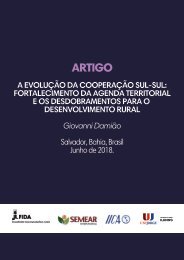The Evolution of South-South Cooperation
Since the Bandung Conference in 1955, the countries of the South have organized themselves in a structured way to achieve better levels of development. This article aims to present the evolution and recent trends of South-South Cooperation, showing how the historical dynamics have led the United Nations and its agencies to adopt a territorial approach, with a strong appeal to mobilize local actors. Allied to this, the increase of the independence of the actors that, with autonomy, manage to dialogue and conduct initiatives of cooperation outside the formal sphere of the central government. This article also aims to present rural development, agriculture and food security as essential factors for the development that since 1978, with BAPA (Buenos Aires Plan of Action), is one of the main thematic lines presented when it comes to the development of the southern agenda. Alongside this, the challenges presented by the prioritization of market dynamics in the face of social development, and how some of the multilateral agencies have worked to promote the facilitation of South-South cooperation and empowerment of minorities, in the achievement of governance as a strategy for endogenous and localized development
Since the Bandung Conference in 1955, the countries of the South have organized themselves in a structured way to achieve better levels of development. This article aims to present the evolution and recent trends of South-South Cooperation, showing how the historical dynamics have led the United Nations and its agencies to adopt a territorial approach, with a strong appeal to mobilize local actors.
Allied to this, the increase of the independence of the actors that, with autonomy, manage to dialogue and conduct initiatives of cooperation outside the formal sphere of the central government. This article also aims to present rural development, agriculture and food security as essential factors for the development that since 1978, with BAPA (Buenos Aires Plan of Action), is one of the main thematic lines presented when it comes to the development of the southern agenda. Alongside this, the challenges presented by the prioritization of market dynamics in the face of social development, and how some of the multilateral agencies have worked to promote the facilitation of South-South cooperation and empowerment of minorities, in the achievement of governance as a strategy for endogenous and localized development
You also want an ePaper? Increase the reach of your titles
YUMPU automatically turns print PDFs into web optimized ePapers that Google loves.
Thus, in conjunction with the localization <strong>of</strong> development, mainly for strengthening rural<br />
areas, the strategy <strong>of</strong> introducing other actors in processes <strong>of</strong> cooperation for development with the<br />
intention <strong>of</strong> promoting governance can be compared to the Multi-stakeholder agenda <strong>of</strong> the<br />
United Nations. Not only due to the inclusion <strong>of</strong> civil society into the decision-making process, but<br />
also due to the greater degree <strong>of</strong> autonomy that subnational units (states and municipalities) had<br />
in that context, which enables them to independently devise cooperation strategies with multilateral<br />
and bilateral agencies, as well as provides them with an open channel for promotion <strong>of</strong><br />
paradiplomacy and dialogue between cities. Brazil utilized well this wave <strong>of</strong> autonomy to advance<br />
its agricultural development projects, specially in the northeastern region, which has one <strong>of</strong> the<br />
highest levels <strong>of</strong> underdevelopment <strong>of</strong> the country. In 1991 the per capita income <strong>of</strong> the region was<br />
BRL 178.44, compared to BRL 459.67 in the <strong>South</strong>east, and, in relation to Brazil, income in the<br />
Northeast was 92% lower than the national average (RIBEIRO; PALES; RODRIGUES, p. 163, 2014).<br />
However, from 2000 to 2010 the Northeast manages to significantly reduce its levels <strong>of</strong><br />
underdevelopment, with the northeastern income being 67% lower than the national income, with<br />
significant increase in distribution and raise in the income <strong>of</strong> classes D and E, which generated this<br />
difference <strong>of</strong> 25% more than the previous years (RIBEIRO; PALES; RODRIGUES, p. 164, 2014). It can<br />
be observed that the social policies and the granting <strong>of</strong> autonomy to local agents were factors that<br />
managed to promote tangible results. In this context, international cooperation among specialized<br />
agencies reaches a high level <strong>of</strong> diffusion, especially in this region, through the structural reforms<br />
that redefine what is understood as territoriality. Brazil, with regard to the use <strong>of</strong> cooperation<br />
strategies aimed at development, becomes a pioneering country and presents cases <strong>of</strong> great<br />
success.<br />
<strong>The</strong> International Fund for Agricultural Development (IFAD) has active participation in the<br />
northeastern semi-arid region and, due to the increasing territorialization <strong>of</strong> policies and<br />
decentralization <strong>of</strong> State institutionality, can dialogue directly not only with government actors in the<br />
means <strong>of</strong> financing, but also with the territories <strong>of</strong> identity (categories derived from the ideas <strong>of</strong><br />
localization <strong>of</strong> development) according to their specific demands and the need for action<br />
programs tailored to each context. In the state <strong>of</strong> Piauí, the Viva o Semiárido Project (PVSA) shows<br />
clearly the consolidation <strong>of</strong> these new trends <strong>of</strong> development and territorialization incorporated into<br />
9 In Bahia and in other states this territorial division is known as territories <strong>of</strong> identity.<br />
15




